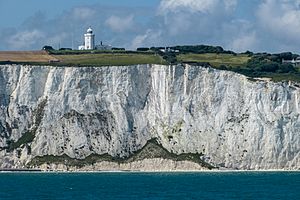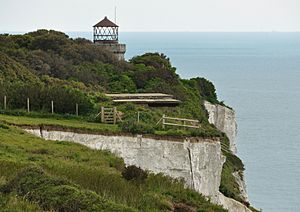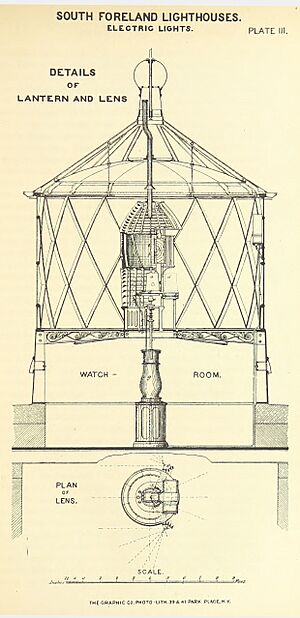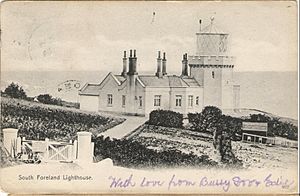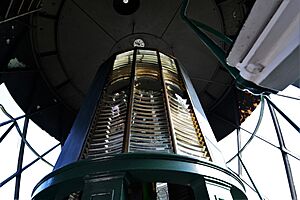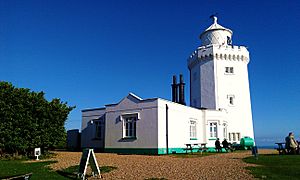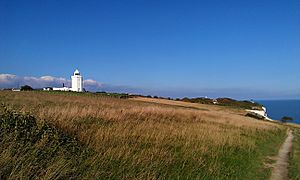South Foreland Lighthouses facts for kids
| Lua error in Module:WikidataIB at line 168: attempt to index field 'wikibase' (a nil value).
Script error: The function "getImageLegend" does not exist.
|
|||
| Location | {{#Property:P17|from= }} Lua error in Module:EditAtWikidata at line 29: attempt to index field 'wikibase' (a nil value). | ||
|---|---|---|---|
| Water body | Lua error in Module:WikidataIB at line 168: attempt to index field 'wikibase' (a nil value). | ||
| Coordinates | Lua error in Module:WikidataIB at line 329: attempt to index field 'wikibase' (a nil value). | ||
| Established | Lua error in Module:WikidataIB at line 168: attempt to index field 'wikibase' (a nil value). | ||
| Designed by | Lua error in Module:WikidataIB at line 168: attempt to index field 'wikibase' (a nil value). | ||
| Built by | Lua error in Module:WikidataIB at line 168: attempt to index field 'wikibase' (a nil value)., Lua error in Module:WikidataIB at line 168: attempt to index field 'wikibase' (a nil value). | ||
| Construction | Lua error in Module:WikidataIB at line 168: attempt to index field 'wikibase' (a nil value). | ||
| Shape | Lua error in Module:WikidataIB at line 168: attempt to index field 'wikibase' (a nil value). | ||
| Power source | Lua error in Module:WikidataIB at line 168: attempt to index field 'wikibase' (a nil value). | ||
| Operator | Lua error in Module:WikidataIB at line 168: attempt to index field 'wikibase' (a nil value). | ||
| Racon | Lua error in Module:WikidataIB at line 168: attempt to index field 'wikibase' (a nil value). | ||
| Active light | |||
| First lit | Lua error in Module:WikidataIB at line 168: attempt to index field 'wikibase' (a nil value). | ||
| Deactivated | Lua error in Module:WikidataIB at line 168: attempt to index field 'wikibase' (a nil value). | ||
| Focal height | Lua error in Module:WikidataIB at line 168: attempt to index field 'wikibase' (a nil value). | ||
| Lens | Lua error in Module:WikidataIB at line 168: attempt to index field 'wikibase' (a nil value). | ||
| Intensity | Lua error in Module:WikidataIB at line 168: attempt to index field 'wikibase' (a nil value). | ||
| Range | Lua error in Module:WikidataIB at line 168: attempt to index field 'wikibase' (a nil value). | ||
| Characteristic | [[File:Lua error in Module:Wd at line 1575: attempt to index field 'wikibase' (a nil value).|20px]] Lua error in Module:WikidataIB at line 168: attempt to index field 'wikibase' (a nil value). | ||
|
|||
The South Foreland Lighthouses are two old lighthouses in England. They are located near Dover, in a place called South Foreland. For hundreds of years, these lighthouses helped warn ships about dangerous sandbanks called the Goodwin Sands.
People have used lighthouses here since the 1630s. Even after one of the lighthouses was turned off, they still helped ships find their way. Maps from the past showed that if ships lined up the two lighthouses, they would safely pass south of the Goodwin Sands.
The South Foreland Upper Lighthouse was built in 1843. It stopped working in 1988 and is now looked after by the National Trust. This lighthouse was very special because it was the first to use an electric light! It was also where Guglielmo Marconi did his important early experiments with wireless radio.
The South Foreland Lower Lighthouse was built at the same time, further down the cliff. It is still there today but is privately owned. It stopped being used in 1904. After the Lower Lighthouse was turned off, the Upper Lighthouse was simply called the South Foreland Lighthouse.
Contents
History of the Lighthouses
The Goodwin Sands have always been dangerous for ships. Long ago, a person named Brother Nicholas de Legh hung a white light from the cliffs nearby. This was one of the earliest ways to warn ships.
Early Lighthouses: 17th and 18th Centuries
The first two lighthouses at South Foreland were built in 1635 by Sir John Meldrum. He also built the first North Foreland Lighthouse a year later. Back then, the light came from an open fire burning in a metal basket on the roof.
Later, in 1730, a man named William Knott became a lighthouse keeper at the Lower Lighthouse. For the next 175 years, five generations of the Knott family worked as lighthouse keepers here. They were probably the longest family of keepers anywhere!
In 1793, the Upper Lighthouse was rebuilt. It started using an oil lamp with special mirrors instead of a fire. The Lower Lighthouse was also rebuilt two years later.
Changes in the 19th Century
In 1832, a group called Trinity House took over the lighthouses. The Upper Lighthouse was partly rebuilt in 1841-42 and made taller. In 1843, it got a new, powerful oil lamp and a large Fresnel lens. This special lens helped make the light much brighter and more focused.
The Lower Lighthouse was completely rebuilt in 1846. It received 15 oil lamps with mirrors. James Walker was the engineer for these projects. New homes for the lighthouse keepers were also built next to each tower.
First Electric Light
In the 1850s, Michael Faraday, a famous scientist, explored using electric light in lighthouses. In 1857, Frederick Hale Holmes showed his electric machine to Faraday. This machine could power carbon arc lamps.
The first test of electric light in a lighthouse happened at South Foreland Upper Lighthouse. It began in December 1858. This made South Foreland the very first lighthouse to use electric light! After this successful test, Holmes's equipment was installed permanently at Dungeness Lighthouse in 1862.
In 1872, South Foreland received its own permanent electric lighting system. A power station was built between the two lighthouses. It had four electric generators powered by steam engines. These engines used coke as fuel. The building also had more rooms for the lighthouse attendants. Both lighthouses also received new, medium-sized lenses designed by James Timmins Chance.
Fog Signal Experiments
From 1865 to 1883, John Tyndall was the scientific adviser to Trinity House. In 1873, Professor Tyndall used South Foreland to test different types of fog signals. He set up various sound machines at the top and bottom of the cliff. These sounds were then listened to from a ship offshore.
He tested steam whistles, air whistles, and brass trumpets. Later, he also tried a steam 'syren' and three types of guns. Tyndall suggested that the siren should be the main fog signal at important coastal stations. By 1884, sirens were used at many lighthouses and on lightships.
Marconi's Wireless Experiments
In 1898, Guglielmo Marconi used South Foreland Lighthouse for his work on radio waves. On Christmas Eve that year, the lighthouse received the first message sent from a ship to the shore. This system helped prevent several shipwrecks that winter. In 1899, the first international wireless message was sent from the lighthouse to France.
20th Century Changes
In 1904, the Lower Lighthouse was no longer needed and was turned off. The tower was sold, and the attached house was taken down. At the same time, a large, rotating lens was installed in the Upper Lighthouse. This lens flashed every 2.5 seconds and could be seen from far away.
The lighthouse was connected to mains electricity in 1922. This made South Foreland Lighthouse the first to use an incandescent lightbulb as its light source. The old electric generators were then disconnected. The number of staff needed at the lighthouse was reduced from five people to just one keeper. If a lightbulb failed, an automatic system would switch to a new one.
In 1925, Guglielmo Marconi returned to South Foreland. He installed an experimental radio guidance system. This system helped ships find their position even when they couldn't see well.
In 1969, the light became fully automated. This meant no keepers were needed anymore, and their homes were sold.
By the mid-1980s, new navigation tools made the South Foreland light unnecessary. It was officially turned off on September 30, 1988.
South Foreland Today
The remains of the old Lower Lighthouse are on private land, so you cannot visit them. The Upper Lighthouse has been owned by the National Trust since 1989. It is open to the public. You cannot drive to the site. Visitors are encouraged to walk from Dover or St Margaret's village, or use the nearby cycle path.
The lighthouse had been dark since 1988. However, in June 2012, the light was turned on again to celebrate the Queen's Diamond Jubilee. The clockwork mechanism that turns the lens was fixed in 2004. The light was also reactivated on June 2, 2022, for the Queen's Platinum Jubilee.
See also
- North Foreland Lighthouse
- List of lighthouses in England


